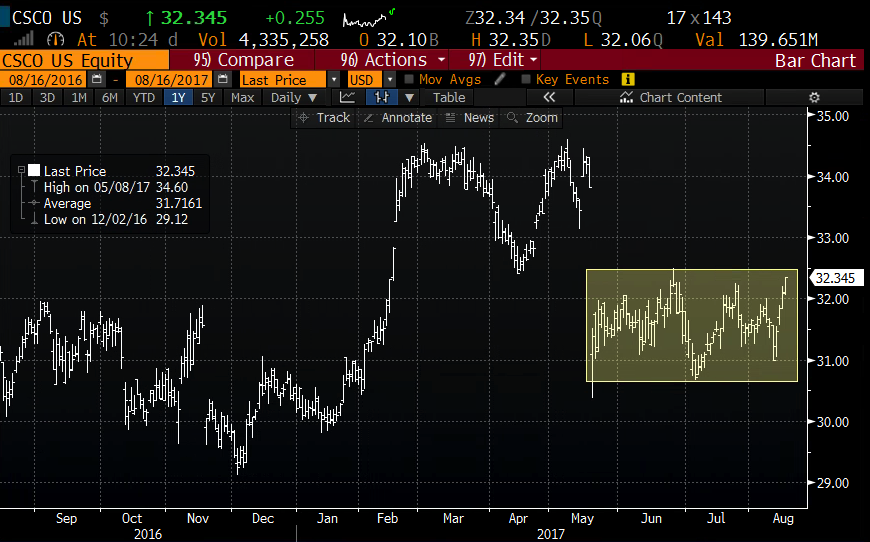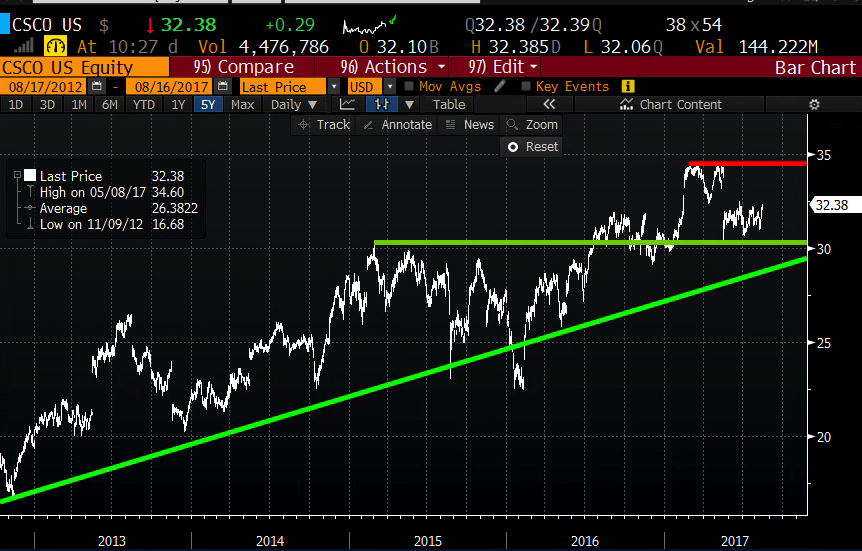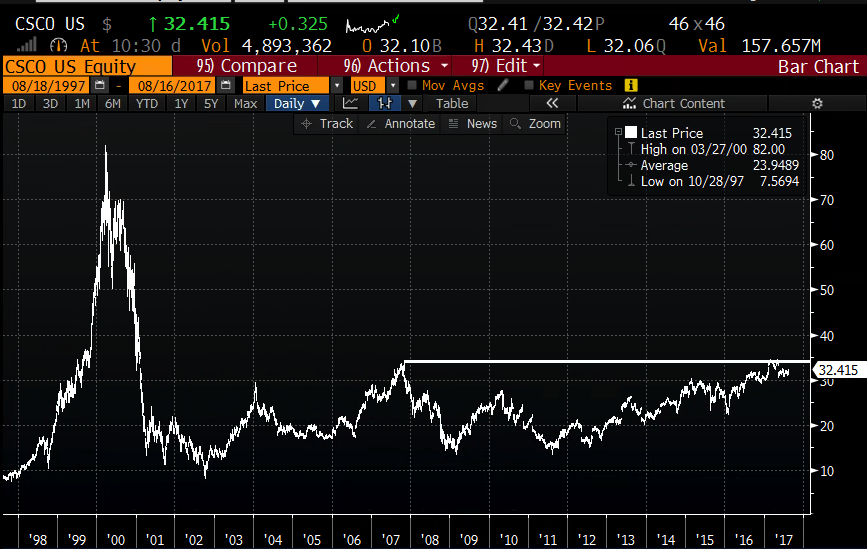Tonight after the close Cisco Systems (CSCO) will report their fiscal Q4 results. The options market is implying about a $1.10, or ~3.4% move in either direction. That can be calculated by dividing the price of the weekly at the money straddle (the at the money put + the at the money call premium) by the strike price. With the stock at $32.40, the August 18th weekly 32.50 straddle is offered at $1.10, if you bought that, and thus the implied move between now and Friday’s close you would need a rally above $33.60, or a decline below $31.40 to make money. CSCO has moved on average about 4% the day following the last 4 quarterly reports, which is shy of its 10-year average one-day post earnings move of about 6%.
Shares of CSCO have underperformed the S&P 500 (SPX) in 2017, up only 7% vs 10.3%), and woefully lags the Nasdaq’s 18% gain. Shares of CSCO decline 7% on May 17th following their fiscal Q3 earnings, largely the result of their weak Q4 guidance calling for about a 5% yoy revenue decline that was below consensus at the time coupled with a lower eps guide. The stock has been range bound since, today trading at very near the high end of the 3-month range of $30.75 and $32.50:

Taking a longer term view, the stock has long term support at $30 which is the intersection of the 5-year uptrend and its 2016 breakout level, with resistance just below its 2017 highs near $35:

But its the 20-year chart that have some traders licking their chops in the hopes of a beat and raise:

Why do you ask? With the Nasdaq at all time highs, and CSCO well below its all time highs made in 2000 its worth noting that while the company’s eps growth has ground to a halt, and sales growth is expected to be negative this year, the company has 41% of their $162 billion market cap in cash (22% net of debt), buys back tons of their stock, pays a dividend that yields 3.58% and the stock trades at only 13x. A classic value trap to say the least.
I suspect Q4 results are low enough and the company meets the lowered guidance, but full year fiscal 2018 guidance is what the stock will trade on, and the current consensus is calling for a reacceleration to growth, albeit a mild one to 3% in eps and 1% for sales. Given CSCO’s disappointing performance so far in 2017, despite what appears to be a healthy but uncertain global economic backdrop, the prospects for a meaningful bump to 2018 guidance is not great.
So what’s the trade?
If I were inclined to play from the long side for a gap fill back to $34…
Bullish Trade Idea:
CSCO ($32.40) Buy Sept 33 / 34 call spread for 35 cents
-Buy to open 1 Sept 33 call for 45 cents
-Sell to open 1 Sept 34 call at 15 cents
Break-Even on Sept Expiration:
Profits: up to 65 cents between 33.35 and 34, max gain of 65 cents above 34
Losses: up to 35 cents between 33 and 33.35 with max loss of 35 cents below 33
Rationale: as always Ill offer our normal disclaimer for long premium directional trades into events, its a tough way to make money, you need to get a lot of things right, first and foremost direction, but timing and magnitude of the move heavily weigh on the probability of success. If you get the direction right this trade should do ok, risking about 1% of the stock price over the next month with a break-even up 3%.
OR BEARISH…
I would look to weekly put spreads. if the results and guidance disappoint I suspect the stock going straight to $30
Bearish / Hedge Trade Idea:
CSCO ($32.40) Buy Aug 32 / 30 put spread for 30 cents
-Buy to open 1 Aug 32 put for 38 cents
-Sell to open 1 Aug 30 put at 8 cents
Break-Even on Aug Expiration:
Profits: up to 1.70 cents between 32 and 30, max gain of 1.70 at 30 or below
Losses: up to 30 cents between 32 and 31.70 with max loss of 30 cents above 32
Rationale: clearly a binary trade, if you get direction wrong the premium is caput. But this trade offers a great risk reward if you think the company will miss and guide lower. Also could be a reasonable short hedge for longs, risking less than 1% of the stock price for break even protection down about 2%.